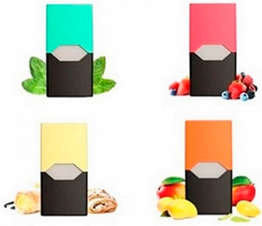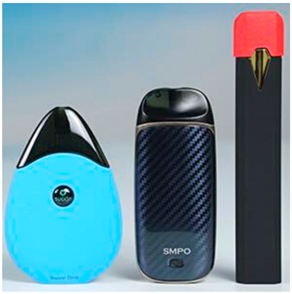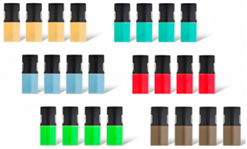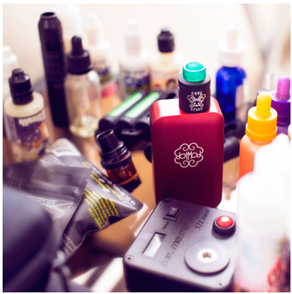Abstract
Introduction: Given the prevalence of electronic vapor product (EVP) use among young people in the US, there is a need for effective vaping education campaigns. This study tested 32 images for liking and perceived effectiveness (PE) to identify optimal images for a messaging campaign. Method: Images were selected from current campaigns, warning labels, and other images based on young adult reasons for use. Images were coded for the presence of (1) people, (2) vapor, (3) device, (4) color, and (5) similarity to warning label image. Young adults (n = 200) were recruited from the Amazon Mechanical Turk platform. Participants were randomly assigned to view and rate six of the 32 images on liking as well as PE, which measured the potential impact of the image to discourage vaping appeal and use. Results: Images containing vapor and/or a device or e-liquid were not well-liked but were perceived as effective in discouraging vaping (ps < 0.05). Images from warning labels were also not well-liked but were perceived as significantly more effective than those not from a warning (p < 0.01). Liking and effectiveness of features was similar for both EVP users and non-users. Discussion: Images with specific features were rated as less likable but rated as higher on PE. However, the consistency of image features rated as effective by EVP users and non-users supports the utility of similar imagery for vaping prevention and reduction efforts.
1. Introduction
Targeted digital media campaigns have emerged as a common strategy for tobacco prevention [1,2,3,4]. Given ongoing health concerns and the rise in vaping among young adults (YAs) [5,6], we developed vaping prevention social media messages [7] due to the US Food and Drug Administration’s initiative to reduce young adult vaping [8]. Formative message testing is an essential part of the message development process. For instance, in a previous study, we found that few vaping prevention message features were rated as likable and effective by YAs. In advertising for consumer products, message likeability predicts advertising success [9,10], and perceived effectiveness (PE) indicates how well the message targets campaign-related beliefs and attitudes [11,12,13]. This study builds on our previous formative work by evaluating the role of the images themselves in liking and PE [7]. Developing and selecting images for vaping prevention campaigns can be challenging because program planners may need to balance selecting features that may attract attention (which may include features that are likable) and show product imagery, with the potential that such features could unintentionally reinforce the appeal of vaping. Thus, consideration of the balance and tradeoffs of participant ratings such as likability and PE may be informative. Image testing alone without text was chosen due to the increased use of picture-based social media (e.g., Instagram) among young adults [14] and to contribute to the limited literature based on potentially effective imagery for vaping prevention communication interventions. Based on findings from previous studies, we expected that images similar to those used in a warning label study [15] and those with people would have higher PE for prevention [16]. We also expected that images with people, color, devices or e-liquid, and vapor would be more likable due to their reported high level of appeal in other studies [16,17]. For instance, prior research has shown that more attention is paid by young adults to the models in EVP advertisements than other features [16]. In addition, another study found that vapor was also an alluring aspect of advertisements for EVPs [17].
2. Materials and Methods
2.1. Sample, Procedures, and Measures
In March 2020, we conducted an online survey of YAs ages 18 to 24 (n = 200) on Amazon’s Mechanical Turk (MTurk). Participants were paid $1.00. After consenting, participants completed sociodemographic and tobacco use questions (including ever and past 30-day electronic vapor product (EVP) use), then were randomized to see six of 33 text-based messages and six of 32 images. Results of the text messages have been described elsewhere [7]; the results of this study focus on the image ratings. Participants saw six images which allowed for adequate viewing numbers for each image while limiting the participant burden. After each image, participants rated the image for likeability (on a five-point scale from “I disliked it very much” to “I liked it very much.” [9,10]) and prevention-related perceived effectiveness (PE). PE was assessed with three questions adapted from a validated scale [18]: This image (1) “discourages me from wanting to vape”, (2) “makes me concerned about the health effects of vaping,” and (3) “makes vaping seem unpleasant to me” on a five-point scale ranging from “strongly disagree” to “strongly agree” [18]. Responses to the three items for each participant were averaged for each image they viewed. These data are from a larger study examining content to reduce vaping [7]. Procedures were approved by the University of Vermont IRB.
2.2. Images and Coding
Images (n = 32) were chosen from Unsplash, a website that houses free stock photography, based on young adult reasons for use (e.g., socializing, flavors) [19,20,21,22] and to be similar to those appearing in prevention campaigns, including those in the United States and United Kingdom, and in a warning label study [23]. Two coders coded all images independently using a codebook developed a priori based on prior research. The coders reached 100% reliability in coding images for: (1) multiple and bright colors present [24], (2) a device or e-liquid container, (3) people—including body parts, (4) vapor, and were (5) similar to those used in an EVP warning label study [23]. No images contained text.
2.3. Data Analysis
We calculated mean likeability and PE for each image (Table 1) and assessed the association between the two using a linear mixed-effects model with restricted maximum likelihood (REML). Univariable (one feature) and multivariable (all features) using a mixed-effects model with REML examined the effect of features on likeability and PE, accounting for multiple observations within subjects. Additional models assessed interactions between EVP use and image features.

Table 1.
Images, coding, likeability, and perceived message effectiveness.
3. Results
3.1. Participants
Participants were largely male (70%), white (60%) and past 30-day EVP users (64%; n = 128). Full sample characteristics are described elsewhere [7]. Overall, 19 (59%) of the images were coded as colorful, 7 (22%) featured a device or e-liquid, 20 (63%) included people, 12 (38%) featured vapor, and 4 (13%) were similar to images in a warning label study. Generally, image likeability and PE were inversely correlated, such that a 1-point increase in mean likeability was associated with a 0.22 decrease in mean PE (95% CI: −0.27, −0.18).
3.2. Image Features: Liking
Mean likeability ranged from 2.39 (Image 18: people, vapor) to 3.97 (Image 2; color; Table 1). Univariable results identified color as the only image feature that was positively associated with likeability, but that was attenuated in the multivariable model (Table 2). Univariable and adjusted results showed that images with the presence of people, vapor, devices or e-liquids, and images from warning labels had lower mean likeability than images without those features. The models testing all image features and including interactions with EVP use status was only significant for not past 30-day users, finding that the presence of a device or e-liquid was less likable in the images than those without it.

Table 2.
Univariable and Multivariable Models Estimating Image Features’ Associations with Likeability and Perceived Effectiveness a.
3.3. Image Features: Perceived Effectiveness
Mean PE ranged from 1.94 (Image 2; color) to 3.40 (Image 32; Table 1; warning). In the univariable and adjusted analysis, images with the presence of vapor and those from a warning label study were rated as more effective than images without those features. The presence of a device/e-liquid was also positively associated with PE in the adjusted model (Table 2).
The models testing interactions between image features by EVP use status showed that presence of vapor was seen as more effective for non-users (Coeff. = 0.60, p < 0.001) and users (Coeff. = 0.27, p < 0.001). The presence of color was seen as less effective for non-users only (Coeff. = −0.23, p < 0.01).
4. Discussion
Image features rated as effective in discouraging vaping in YAs (i.e., presence of vapor, device/e-liquid, warning images) were rated as less likable than images without those features. In models adjusting for all image features, color was not associated with likeability or PE and the presence of people reduced the likeability of images with no effect on PE, contrary to our expectations which were supported by prior research on EVP messaging appeal [16,17,25]. Results were comparable in past 30-day EVP users and non-users, supporting the utility of similar imagery in vaping prevention and reduction efforts. These results differed from our message-testing in the same sample, in which the likeability and perceived effectiveness of text-only messages were positively correlated [7]. Our findings suggest that the inclusion of some features like color or vapor may only signal one of the two motivational systems (i.e., appetitive and aversive) when a balance of the two might be best for health communication [25]. For instance, it could be that features that are well-liked by young adults may not actually be the images that are effective in preventing vaping. In a past study, young adults found models in EVP advertisements more attention-grabbing than other features [16]. This may not translate to messages aimed at preventing vaping. Health communicators should consider the differences between liking and PE when pre-testing messages for campaigns. In addition, health communicators also might consider that effective imagery may be the same for EVP users and non-users.
This study has several limitations. First, the sample was drawn from MTurk and included a high proportion of EVP users. MTurk has been used in other tobacco surveys [26] with survey samples that are comparable to experimental and population samples, [27], but our findings may not be generalizable. Second, the study only tested 32 images and five features in a relatively small sample and there could be many more features that impact liking and PE. In addition, there was an unequal distribution of features within the messages and many of the images were stock photos not specifically designed for EVP messaging. Third, since measures of liking are often borrowed from the advertising literature [28], it may be that this measure does not always translate to health education campaigns. Finally, the application of a PE scale to assess image effectiveness was novel and not well-established in the literature. Future studies should explore the usefulness of these images using other established measures as well, including attention.
5. Conclusions
Our prior study used the overall likeability and PE ratings to determine the images to be paired with vaping-related messages in a subsequent trial; results from that study suggested that the images had no effect on the overall likeability or effectiveness of the message/image pairs in a separate sample of YAs [7]. The current analyses, however, highlight that different images may have been selected for inclusion in our message optimization trial, based on the specific features of the images deemed to be effective in discouraging vaping, rather than the overall ratings. The findings highlight common elements of imagery likely to be effective in reducing vaping in YAs, specifically warning images. Future studies addressing a greater range of image features are needed to optimize the images used in vaping prevention campaigns and determine whether and how these features enhance their effectiveness.
Author Contributions
Conceptualization, E.M.S., B.K.-H., D.M., J.B.U. and A.C.V.; methodology, E.M.S., J.B.U. and A.C.V.; formal analysis, B.K.-H.; investigation, A.C.V.; resources, A.C.V.; data curation, B.K.-H.; writing—original draft preparation, E.M.S.; writing—review and editing, E.M.S., B.K.-H., D.M.; J.B.U.; O.A.W., J.C.W. and A.C.V.; supervision, A.C.V.; project administration, A.C.V.; funding acquisition, A.C.V. All authors have read and agreed to the published version of the manuscript.
Funding
Research reported in this publication was supported by the National Institute on Drug Abuse of the National Institutes of Health under Award Number U54 DA036114. The authors were also supported by R00DA046563 (EMS) and awards from the National Cancer Institute of the National Institutes of Health under Award Numbers U54 CA180905 (JBU) and U54 CA229973 (OAW, DM). The content is solely the responsibility of the authors and does not necessarily represent the official views of the National Institutes of Health. The funding sponsors had no role in study design, collection, analysis, or interpretation of data, writing the manuscript, or the decision to submit the manuscript for publication.
Institutional Review Board Statement
The study was conducted according to the guidelines of the Declaration of Helsinki, and approved by the Institutional Review Board of the University of Vermont (protocol code STUDY00000693 and 18 February 2020).
Informed Consent Statement
Informed consent was obtained from all subjects involved in the study.
Data Availability Statement
Data available upon request.
Conflicts of Interest
The authors declare that they have no known competing financial interest or personal relationships that could have appeared to influence the work reported in this paper.
References
- Crankshaw, E.; Gaber, J.; Guillory, J.; Curry, L.; Farrelly, M.; Saunders, M.; Hoffman, L.; Ganz, O.; Delahanty, J.; Mekos, D.; et al. Final evaluation findings for this free life, a 3-Year, multi-market Tobacco public education campaign for gender and sexual minority young adults in the United States. Nicotine Tob. Res. 2021. [Google Scholar] [CrossRef]
- Guillory, J.; Crankshaw, E.; Farrelly, M.C.; Alam, I.; Fiacco, L.; Curry, L.; Hoffman, L.; Ganz, O.; Delahanty, J. LGBT young adults’ awareness of and receptivity to the this free life tobacco public education campaign. Tob. Control 2021, 30, 63–70. [Google Scholar] [CrossRef]
- Guillory, J.; Henes, A.; Farrelly, M.C.; Fiacco, L.; Alam, I.; Curry, L.; Ganz, O.; Hoffman, L.; Delahanty, J. Awareness of and receptivity to the fresh empire tobacco public education campaign among Hip Hop youth. J. Adolesc. Health 2020, 66, 301–307. [Google Scholar] [CrossRef]
- Navarro, M.A.; Hoffman, L.; Crankshaw, E.C.; Guillory, J.; Jacobs, S. LGBT identity and its influence on perceived effectiveness of advertisements from a LGBT tobacco public education campaign. J. Health Commun. 2019, 24, 469–481. [Google Scholar] [CrossRef]
- Cornelius, M.E.; Wang, T.W.; Jamal, A.; Loretan, C.G.; Neff, L.J. Tobacco product use among adults—United States, 2019. MMWR Morb. Mortal. Wkly. Rep. 2020, 69, 1736–1742. [Google Scholar] [CrossRef]
- Leventhal, A.M.; Dai, H. Prevalence of flavored e-cigarette use among subpopulations of adults in the United States. JNCI J. Natl. Cancer Inst. 2021, 113, 418–424. [Google Scholar] [CrossRef]
- Villanti, A.C.; LePine, S.E.; West, J.C.; Cruz, T.B.; Stevens, E.M.; Tetreault, H.J.; Unger, J.B.; Wackowski, O.A.; Mays, D. Identifying message content to reduce vaping: Results from online message testing trials in young adult tobacco users. Addict. Behav. 2021, 115, 106778. [Google Scholar] [CrossRef]
- U.S. Department of Health and Human Services; Centers for Disease Control and Prevention; National Center for Chronic Disease Prevention and Health Promotion; Office on Smoking and Health. Preventing Tobacco Use among Youth and Young Adults: A Report of the Surgeon General; Centers for Disease Control and Prevention (US): Atlanta, GA, USA, 2012.
- Vakratsas, D.; Ambler, T. How advertising works: What do we really know? J. Mark. 1999, 63, 26–43. [Google Scholar] [CrossRef]
- Davis, K.C.; Nonnemaker, J.; Duke, J.; Farrelly, M.C. Perceived effectiveness of cessation advertisements: The importance of audience reactions and practical implications for media campaign planning. Health Commun. 2013, 28, 461–472. [Google Scholar] [CrossRef]
- Duke, J.C.; Nonnemaker, J.M.; Davis, K.C.; Watson, K.A.; Farrelly, M.C. The impact of cessation media messages on cessation-related outcomes: Results from a National Experiment of Smokers. Am. J. Health Promot. 2014, 28, 242–250. [Google Scholar] [CrossRef]
- Zhao, X.; Alexander, T.N.; Hoffman, L.; Jones, C.; Delahanty, J.; Walker, M.; Berger, A.T.; Talbert, E. Youth receptivity to FDA’s the real cost tobacco prevention campaign: Evidence from message pretesting. J. Health Commun. 2016, 21, 1153–1160. [Google Scholar] [CrossRef] [Green Version]
- Perrin, A.; Anderson, M. Share of U.S. Adults Using Social Media, Including FACEBOOK, Is Mostly Unchanged Since 2018; Pew Research Center: Washington, DC, USA, 2019. [Google Scholar]
- Francis, D.B.; Mason, N.; Ross, J.C.; Noar, S.M. Impact of tobacco-pack pictorial warnings on youth and young adults: A systematic review of experimental studies. Tob. Induc. Dis. 2019, 17, 41. [Google Scholar] [CrossRef]
- Stevens, E.M.; Johnson, A.L.; Leshner, G.; Sun, F.; Kim, S.; Leavens, E.L.S.; Tackett, A.P.; Hebert, E.T.; Wagener, T.L. People in E-cigarette ads attract more attention: An eye-tracking study. Tob. Regul. Sci. 2020, 6, 105–117. [Google Scholar] [CrossRef]
- Alpert, J.M.; Chen, H.; Adams, K.-A. E-cigarettes and social media: Attitudes and perceptions of young adults to social media messages. Addict. Res. Theory 2020, 28, 387–396. [Google Scholar] [CrossRef]
- Baig, S.A.; Noar, S.M.; Gottfredson, N.C.; Boynton, M.H.; Ribisl, K.M.; Brewer, N.T. UNC Perceived message effectiveness: Validation of a brief scale. Ann. Behav. Med. 2018, 53, 732–742. [Google Scholar] [CrossRef]
- Cavallo, D.A.; Kong, G.; Ells, D.M.; Camenga, D.R.; Morean, M.E.; Krishnan-Sarin, S. Youth generated prevention messages about electronic cigarettes. Health Educ. Res. 2019, 34, 247–256. [Google Scholar] [CrossRef]
- Villanti, A.C.; Johnson, A.L.; Ambrose, B.K.; Cummings, K.M.; Stanton, C.A.; Rose, S.W.; Feirman, S.P.; Tworek, C.; Glasser, A.M.; Pearson, J.L.; et al. Flavored tobacco product use in youth and adults: Findings from the first wave of the PATH study (2013–2014). Am. J. Prev. Med. 2017, 53, 139–151. [Google Scholar] [CrossRef]
- Ickes, M.; Hester, J.W.; Wiggins, A.T.; Rayens, M.K.; Hahn, E.J.; Kavuluru, R. Prevalence and reasons for Juul use among college students. J. Am. Coll. Health 2020, 68, 455–459. [Google Scholar] [CrossRef]
- Leavens, E.L.S.; Stevens, E.M.; Brett, E.I.; Hébert, E.T.; Villanti, A.C.; Pearson, J.L.; Wagener, T.L. JUUL electronic cigarette use patterns, other tobacco product use, and reasons for use among ever users: Results from a convenience sample. Addict. Behav. 2019, 95, 178–183. [Google Scholar] [CrossRef]
- Brewer, N.T.; Jeong, M.; Hall, M.G.; Baig, S.A.; Mendel, J.R.; Lazard, A.J.; Noar, S.M.; Kameny, M.R.; Ribisl, K.M. Impact of e-cigarette health warnings on motivation to vape and smoke. Tob. Control 2019, 28, E64–E70. [Google Scholar] [CrossRef] [Green Version]
- Banerjee, S.C.; Shuk, E.; Greene, K.; Ostroff, J.S. Content analysis of trends in print magazine tobacco advertisements. Tob. Regul. Sci. 2015, 1, 103–120. [Google Scholar] [CrossRef] [PubMed] [Green Version]
- Mays, D.; Villanti, A.; Niaura, R.S.; Lindblom, E.N.; Strasser, A.A. The effects of varying electronic cigarette warning label design features on attention, recall, and product perceptions among young adults. Health Commun. 2019, 34, 317–324. [Google Scholar] [CrossRef] [PubMed] [Green Version]
- Bailey, R.L.; Wang, T.; Kaiser, C.K. Clash of the primary motivations: Motivated processing of emotionally experienced content in fear appeals about obesity prevention. Health Commun. 2018, 33, 111–121. [Google Scholar] [CrossRef]
- Leavens, E.L.S.; Stevens, E.M.; Brett, E.I.; Leffingwell, T.R.; Wagener, T.L. JUUL in school: JUUL electronic cigarette use patterns, reasons for use, and social normative perceptions among college student ever users. Addict. Behav. 2019, 99, 106047. [Google Scholar] [CrossRef] [PubMed]
- Jeong, M.; Zhang, D.; Morgan, J.C.; Ross, J.C.; Osman, A.; Boynton, M.H.; Mendel, J.R.; Brewer, N.T. Similarities and differences in tobacco control research findings from convenience and probability samples. Ann. Behav. Med. 2019, 53, 476–485. [Google Scholar] [CrossRef]
- Haley, R.I.; Baldinger, A.L. The ARF copy research validity project. J. Advert. Res. 2000, 40, 114–135. [Google Scholar] [CrossRef]
Publisher’s Note: MDPI stays neutral with regard to jurisdictional claims in published maps and institutional affiliations. |
© 2021 by the authors. Licensee MDPI, Basel, Switzerland. This article is an open access article distributed under the terms and conditions of the Creative Commons Attribution (CC BY) license (https://creativecommons.org/licenses/by/4.0/).































